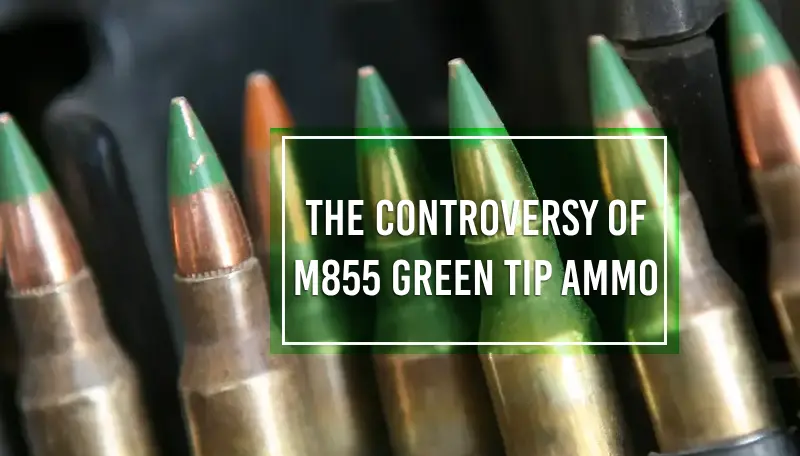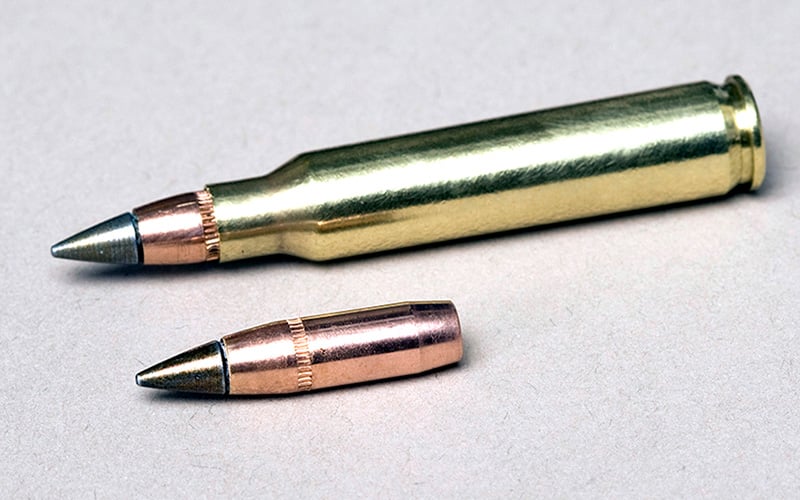
If you’re a regular reader of firearm news and issues and have been a part of the community for a while, then you must remember the stir around the M855 / SS109 round that took place in 2015. These rounds, commonly known as green tip rounds because of their color coding, are designed for use with the AR platform in the popular caliber of 5.56. However, the ATF was planning to withdraw these rounds from the civilian market citing their armor piercing capabilities. Prior to that, the round has been generally grouped together with proper “black tip” armor piercing rounds, but the M855 received an exception because it did not possess the same characteristics of an armor piercing round.

The ATF argued that the M855 was dangerous to those who wear body armor like law enforcement officers, especially when used with the AR pistol platform. Yet critics of the ban argued that removing the round from the market would destabilize the already shaky market for AR ammunition. Let’s examine this debate in more detail so you have the full picture. The ATF had actually been calling for open feedback from anyone concerned about the withdrawal of this round until March 16, 2015, so the concerned citizens had time to speak up.
Why Bring This Up Now?
This article was originally written in February 2015, when the issue was as relevant as ever. You can jump right to the conclusion if you don’t know the answer or can’t wait to learn it, but here’s the reason we decided to update this article.
Two years later, the White House tried to limit the production of the green tip ammo at the Lake City Army Ammunition Plant in Missouri, which supplies about 30% of 5.56x45mm and .223 Remington ammunition. The talks were many, but nothing seemed to change. Until the following year, 2023, when the plant was rumored to cancel all its commercial contracts.
The alleged reasons were many, the main one being the need to address the issue of ammo shortage within the military. The plant would continue to function, but would not produce ammo for the civilian market, which would inevitably affect the ammo supply and prices. Even though the Lake City Plant proved those rumors wrong, the talks still caused quite a commotion. Now that the dust has settled, it might be useful to remember where it all came from and maybe get ready to uphold our interest once again.
What Makes A Round Armor Piercing?
We’ll cite the full ATF definition in a second, but to simplify it first, armor piercing ammo is classified either by the contents of the core of the bullet or the jacket weight (or really concentration) of the jacket in regard to the rest of the bullet. Armor piercing rounds need added weight to help punch through tougher targets, that’s why the core of traditional armor piercing rounds usually consist of iron, steel, brass, bronze, tungsten alloy, beryllium copper, or depleted uranium. These materials are far denser than lead and give the round the added weight it needs. This can also be accomplished by a thicker brass jacket, and this is measured by the percentage of the jacket in regard to the rest of the bullet. If a FMJ round (.22 rounds are excluded) has a jacket that exceeds 25% of the total weight of the projectile, then it is considered armor piercing.

In the ATF’s terms for accuracy:
- (i) a projectile or projectile core which may be used in a handgun and which is constructed entirely (excluding the presence of traces of other substances) from one or a combination of tungsten alloys, steel, iron, brass, bronze, beryllium copper or depleted uranium; or
- (ii) a full jacketed projectile larger than .22 caliber designed and intended for use in a handgun and whose jacket has a weight of more than 25 percent of the total weight of the projectile.
Why The M855 Green Tip Ammo Isn’t Classified As Armor Piercing
The real outrage that critics had of the pending ATF ban was that M855 did’t fall into either of the above categories. Its core was still lead like many conventional bullets, and its jacket did not weigh over 25% of the total weight of the projectile. The bullet did have a steel tip, but that was not mentioned in the above classifications released by the ATF.
When we began to examine why the M855 was developed, the confusion of why it was to be banned grew for many. It was originally selected by NATO in their search to standardize a second caliber. They decided upon the SS109 which had been designed for use in FN Herstal firearms like the the FN FNC rifle and the FN Minimi machine gun. The round was essentially developed to increase the range of the FN Minimi machine gun, and NATO selected it as the best option out of the ammunition it tested. Given the debate, it’s important to note that the SS109 was not required to pierce body armor, and it was not designed or tested for such. Soon after NATO examined the SS109, the US Military designated it at the M855, but they are the same round.

As the M855 round was tested in combat, more concerns began to develop surrounding the round. It proved fairly ineffective at longer ranges, and in certain examples it wasn’t even able to pierce the windshield of a vehicle, and this included rounds that were fired at a very close range. It also performed very poorly out of a short barreled rifle, and it was excepted that this round was only suitable for longer barreled rifles. The one thing that was particularly desirable was that the M855 rounds were relatively cheap. All in all, the M855 did not perform as desired, and it has been phased out of military service and replaced by its counterpart M855A1 ammunition. M855A1 has problems of its own, but it is classified as armor piercing since its core is no longer made of lead. However, none of this matters when it comes to the civilian market because the M855A1 rounds are not available to the public.

So Why Ban Green Tip Ammo?
This lead the already suspicious consumer to wonder why the ATF was banning this ammo then after having been allowing it as an exception for many years. The main reason that the ATF cited was s the rising popularity of AR style pistols. Because the AR pistol was considered “more concealable” than an AR rifle, the ATF worried that these rounds could be used against those wearing body armor. Critics were quick to counter and cite back that the round wasn’t developed to pierce body armor and that it generally performed very poorly out of an AR pistol in the first place. You could also make the argument that an AR pistol isn’t very concealable when compared to a handgun anyway.
The fact was that green tip ammunition was still relatively cheap in an expensive ammunition market, and critics of the ATF’s ruling argued that banning this type of ammo could drive up pricing on all 5.56 ammunition. Certainly no avid shooting enthusiast liked the sound of rising ammunition prices or a buying frenzy. I guess you could say that was happening nonetheless, at least when it came to M855 rounds.
But the real kicker of this ban came with the concerns surrounding the classification of a round used for sporting purposes. Ammunition is exempt from the armor piercing ban if it is primarily designed for sporting purposes, as the M855 has been used for since its appearance on the civilian market, and the re-classification of a round previously viewed as sporting to armor piercing was sure to make most every hunter nervous. After all, their hunting rounds could have been subject to the same “re-interpretation” if this ban had succeeded.
How Did It End?
The ATF apparently hoped that gun owners would stay idle in the face of the potential ban. They played the wrong card. The voices of the aggrieved public were too loud to be ignored, even for an institution like the ATF. The Bureau and the White House decided to back off from the proposed ban. The ATF admitted that they had reconsidered their decision due to the overwhelming public response against the ban. As of today, it is still legal to purchase and possess green tip or M855 5.56mm NATO ammo in the United States. We don’t allow to use green tip ammo on our GRITR Range because of its potential to cause collateral damage, but otherwise, it’s readily available for purchase on our website.
Read: Best 5.56 Ammo for Your Rifle
Images one, two and thumb, three, and four all courtesy of Wikimedia Commons.
FAQs
Green Tip Ammo refers to M855 5.56mm NATO ammunition that has a green painted tip to identify it as having a steel penetrator tip over a lead core in a full copper jacket.
In 2015, the Bureau of Alcohol, Tobacco, Firearms and Explosives (ATF) proposed a ban on Green Tip Ammo, citing concerns that the rounds could be used in concealable, non-sporting firearms against law enforcement officers.
The ATF proposed the ban as part of an effort to protect law enforcement officers from armor-piercing rounds that could be fired from handguns.
Due to the overwhelming public response against the ban, the ATF and the White House decided to back off from the proposal. As of today, it is still legal to purchase and possess Green Tip Ammo in the United States.
No, as of now, there are no federal restrictions on purchasing or possessing Green Tip Ammo. However, state and local laws may vary, so it’s always advisable to check your local regulations.




Comments (0)
2015 Articles In Review | The Blog of the Gritr Sports Storesays:
December 31, 2015 at 2:33 pm[…] We were sure to touch on some of the pressing issues that impacted hunters in shooters in 2105 like the pending green tip ammo ban in: What Makes M855 “Green Tip” Ammo So Controversial? […]